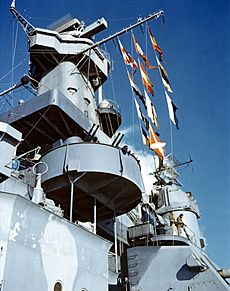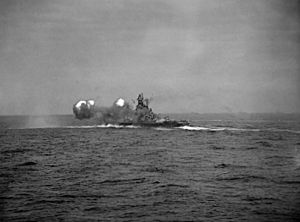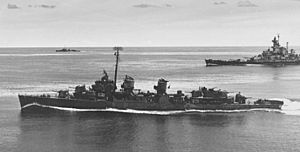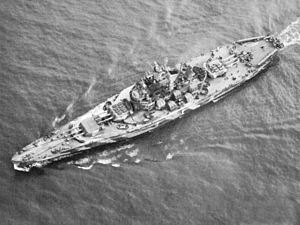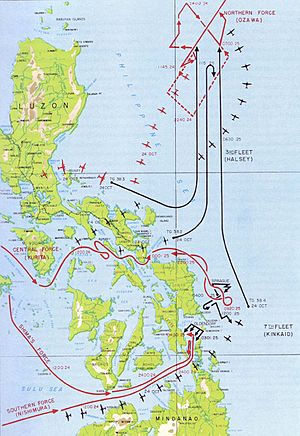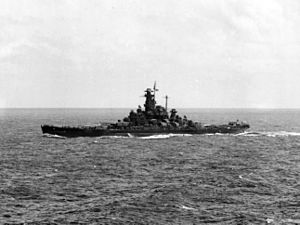USS Alabama (BB-60) facts for kids
The USS Alabama (BB-60) is a famous retired battleship that served in the United States Navy. She was the fourth and last ship of the South Dakota class class. These battleships were designed to be very fast and powerful. They were built in the 1930s, after some international agreements about ship sizes started to change. This allowed them to have very large 16-inch (406 mm) guns, but they still had to be close to a certain size limit. This made them strong but also a bit cramped inside. During World War II, many changes were made to add more anti-aircraft guns, which also meant more crew members.
After she was built, Alabama first helped the British Navy protect ships traveling to the Soviet Union. In 1943, she moved to the Pacific Ocean to fight against Japan. There, she mostly protected aircraft carriers from enemy planes and ships. She also fired her big guns at Japanese positions on islands to help American troops land. Alabama took part in many important battles, including campaigns in the Marshall Islands, Mariana Islands, and the Philippines.
After the war, Alabama helped bring soldiers home. She was taken out of service in 1947. Later, in 1962, people decided to save her from being taken apart for scrap metal. Enough money was raised, and in 1964, Alabama became a museum ship in Mobile Bay, Alabama, where you can visit her today.
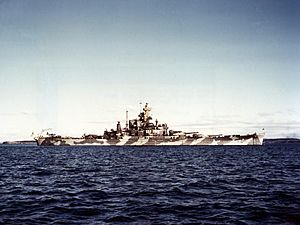
USS Alabama in Casco Bay in 1942
|
|
Quick facts for kids History |
|
|---|---|
| Name | Alabama |
| Namesake | State of Alabama |
| Ordered | 1 April 1939 |
| Builder | Norfolk Naval Shipyard |
| Laid down | 1 February 1940 |
| Launched | 16 February 1942 |
| Commissioned | 16 August 1942 |
| Decommissioned | 9 January 1947 |
| Stricken | 1 June 1962 |
| Status | Museum ship since 11 June 1964 at the Battleship Memorial Park |
| General characteristics | |
| Class and type | South Dakota-class battleship |
| Displacement | |
| Length | 680 ft (210 m) o/a |
| Beam | 108 ft 2 in (32.97 m) |
| Draft | 35 ft 1 in (10.69 m) |
| Installed power |
|
| Propulsion | |
| Speed | 27.5 knots (50.9 km/h; 31.6 mph) |
| Range | 15,000 nmi (28,000 km; 17,000 mi) at 15 knots (28 km/h; 17 mph) |
| Crew |
|
| Armament |
|
| Armor |
|
| Aircraft carried | 3 × "Kingfisher" floatplanes |
| Aviation facilities | 2 × catapults |
Contents
Building and Design of the USS Alabama
The USS Alabama was part of the South Dakota class class. These ships were ordered when countries around the world started building up their navies again. Before this, agreements like the Washington Naval Treaty limited the size and guns of battleships.
Why was the Alabama designed this way?
In 1936, Japan decided to leave these agreements. This allowed the United States to build bigger ships with larger guns. The new rules let battleships be up to 45,000 long tons (46,000 t) and have 16 in (410 mm) guns. However, the U.S. Congress wanted the ships to stay as close to the old 35,000 long tons (36,000 t) limit as possible. This meant designers had to fit powerful guns and strong armor into a smaller space.
What were the Alabama's features?
The Alabama was 680 feet (210 m) long. She was 108 ft 2 in (32.97 m) wide and had a draft of 35 ft 1 in (10.69 m). When fully loaded for battle, she weighed about 44,519 long tons (45,233 t). Four powerful steam turbines made her go, using steam from eight boilers. These engines gave her a top speed of 27.5 knots (50.9 km/h; 31.6 mph). She could travel 15,000 nautical miles (28,000 km; 17,000 mi) at a speed of 15 knots (28 km/h; 17 mph).
The ship carried three Vought OS2U Kingfisher floatplanes. These planes were used for scouting and were launched by two catapults at the back of the ship. In peacetime, her crew was 1,793 sailors. But during the war, this number grew to 2,500.
What weapons did the Alabama have?
Alabama had nine 16 in (406 mm) guns. These were in three large gun turrets. Two turrets were at the front, and one was at the back. She also had twenty 5 in (127 mm) guns. These were in ten twin turrets along the sides of the ship.
For protection against aircraft, she had six quadruple 40 mm (1.6 in) Bofors guns. She also had thirty-five single 20 mm (0.8 in) Oerlikon cannons.
How strong was her armor?
The main armor belt around the ship was 12.2 in (310 mm) thick. The main deck armor was up to 6 in (152 mm) thick. The gun turrets had 18 in (457 mm) thick faces. The conning tower, where the ship was commanded, had 16 in (406 mm) thick sides.
How was the Alabama updated during the war?
Throughout the war, Alabama received many updates. Most of these were to improve her anti-aircraft guns and add new radar systems.
- Radar: Early on, she got radar to detect aircraft and ships. Later, she received more advanced radar to help aim her main and secondary guns. This radar was very important for finding enemy planes and ships, especially at night.
- Anti-Aircraft Guns: Her anti-aircraft guns were constantly increased. More 40 millimetres (1.6 in) quadruple mounts were added. The number of 20 millimetres (0.79 in) guns also grew to fifty-six by 1945. These guns were crucial for defending the fleet from enemy air attacks.
Service History of the USS Alabama
Building and Early Atlantic Missions
The Alabama was built at the Norfolk Naval Shipyard. Her construction started on February 1, 1940. She was launched on February 16, 1942. Just six months later, on August 16, she was officially put into service. After some training, she was ready for duty.
In April 1943, Alabama was sent to join the British Home Fleet. Her job was to help protect convoys, which were groups of supply ships, traveling to the Soviet Union. This was important because the British needed more warships to counter German naval power. Alabama and her sister ship South Dakota sailed to Scapa Flow, a British naval base. There, they trained with British battleships to learn how to work together.
Alabama also took part in Operation Governor. This was a fake operation to make the Germans think the Allies were attacking somewhere else. It also hoped to lure out the German battleship Tirpitz, but it didn't work. In August 1943, Alabama returned to the United States. She then went through the Panama Canal to prepare for fighting in the Pacific Ocean against Japan.
Fighting in the Pacific Ocean
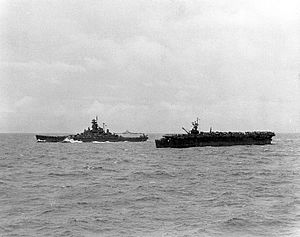
When Alabama arrived in the Pacific, she trained for a month and a half. This prepared her to work with the fast carrier task force. This group of ships included aircraft carriers and their escorts.
Gilbert and Marshall Islands Campaign
In November 1943, Alabama supported the Gilbert and Marshall Islands campaign. She protected aircraft carriers as they attacked Japanese airfields. This stopped Japanese planes from interfering with American landings. She also helped support the landings on Tarawa and Makin. Alabama even fought off Japanese planes that attacked the fleet at night.
On December 8, Alabama and other battleships shelled Nauru. This island was important to the Japanese for its phosphate. After this, she went to Pearl Harbor for maintenance. She then joined the fleet for the Battle of Kwajalein in January 1944. Alabama and two other battleships fired at Japanese defenses on Roi-Namur.
Over the next two months, the fast carrier task force attacked Japanese islands in the central Pacific. Alabama escorted carriers during a big raid on Truk in February. Truk was a major Japanese base. The fleet then attacked Saipan, Tinian, and Guam. During an air attack on February 21, one of Alabama's guns accidentally fired into another gun mount, sadly killing five sailors and wounding eleven.
In March, Alabama helped protect carriers attacking islands in the Caroline Islands. She shot down one Japanese plane and helped with another. She also helped drive off a lone Japanese plane later that day. In April, she escorted the carrier Enterprise during attacks along the coast of New Guinea. On May 1, Alabama and five other battleships bombarded Pohnpei.
Mariana and Palau Islands Campaign
In June, Alabama sailed with the fleet to Saipan. On June 13, she took part in shelling the island to prepare for the landing. Her gunners were not as good at shore bombardment as other ships. After the troops landed on June 15, the Japanese fleet launched a big counter-attack.
This led to the Battle of the Philippine Sea on June 19. Alabama was the first ship to detect the incoming Japanese planes on her radar. This early warning helped American carriers launch their fighter planes in time. Alabama helped shoot down Japanese planes that tried to attack the fleet. She fired a lot of anti-aircraft shells. One Japanese dive bomber tried to attack Alabama, but missed.
Alabama continued to escort carriers as they attacked Saipan, Guam, Tinian, and Rota. She then went for maintenance. She later became the flagship for Rear Admiral Edward Hanson. She continued to escort carriers during the invasion of Guam in July. In August, she supported landings on Peleliu, Ulithi, and Yap.
Philippines Campaign
After the Caroline Islands, the fleet attacked the Philippines. From September 12 to 14, aircraft from the carriers hit Japanese bases on islands like Cebu and Leyte. More attacks followed on Manila and the central Philippines. Alabama returned to Ulithi, a major U.S. fleet base.
On October 6, the fleet sailed to attack Taiwan and other islands. This was to clear the way for the invasion of the Philippines. Alabama continued to protect the carriers with her anti-aircraft guns. On October 14, the fleet turned south to attack Luzon. Alabama's gunners claimed to have shot down three Japanese planes.
Battle of Leyte Gulf
Alabama supported the landing at Leyte on October 15. This landing caused the Japanese navy to launch a big counter-attack plan called Operation Shō-Gō 1. This plan involved three Japanese fleets. One fleet, the Northern Force, was meant to be a decoy.
On October 24, the American fleet found the Japanese Center Force. American carrier planes attacked them, sinking the battleship Musashi. This made the Japanese commander turn back for a short time. Admiral William F. Halsey, the American commander, decided to send his fast carrier task force, including Alabama, to destroy the decoy Northern Force.
Alabama sailed north with the carriers. On October 25, American planes attacked the Northern Force, sinking all four Japanese aircraft carriers. However, the Japanese Center Force had turned around again and was now attacking the American invasion fleet. Halsey sent Alabama and other battleships south to help. But they arrived too late. The Center Force had already been driven off by smaller American ships.
Later Operations
Alabama and the other battleships returned to protecting the carriers. On October 30, the fleet went to Ulithi to resupply. On November 3, they attacked Japanese airfields on Luzon again. This was to prepare for the next landing on Mindoro. Alabama protected the carriers as they struck targets on Luzon and the central Philippines.
On December 17, the fleet was hit by Typhoon Cobra. Alabama recorded very strong winds and big waves. Three destroyers sank, and other ships were damaged. Alabama only had minor damage. After repairs, she went to Puget Sound Naval Shipyard for a major overhaul. This lasted until March 1945.
Operations off Japan and the End of the War
In April 1945, Alabama rejoined the fast carrier task force. On May 9, they sailed to support the Battle of Okinawa. The Japanese used many kamikaze planes to attack the American fleet. On May 14, Alabama shot down two Japanese planes and helped destroy two others.
On June 4–5, another typhoon hit the fleet. Alabama again had only minor damage. On June 9, Alabama, Indiana, and Massachusetts shelled Japanese facilities on Minami Daito Jima. The fleet then returned to prepare for attacks on the Japanese mainland.
Starting July 1, the fleet attacked military and industrial targets across Japan. On the night of July 17–18, Alabama and other battleships bombarded six industrial sites near Tokyo. On August 9, Alabama shelled targets at Kamaishi. On the same day, she sent a medical team to help a destroyer hit by a kamikaze. When Japan surrendered on August 15, Alabama was still at sea off Japan.
On September 5, Alabama entered Tokyo Bay. She picked up her crew members who had gone ashore. On September 20, she sailed to Okinawa. There, she took on 700 men, mostly Seabees (Navy construction workers), to take them back to the United States. This was part of Operation Magic Carpet. She arrived in San Francisco on October 15. She hosted about 9,000 visitors for Navy Day celebrations.
Becoming a Museum Ship
|
USS Alabama (battleship)
|
|
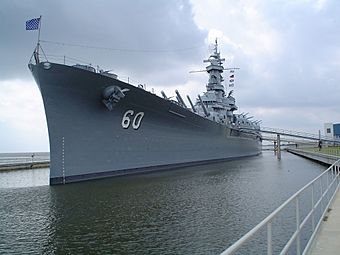
USS Alabama at her permanent home.
|
|
| Built | 1964 for museum |
|---|---|
| NRHP reference No. | 86000083 |
| Significant dates | |
| Added to NRHP | 14 January 1986 |
| Designated NHL | 14 January 1986 |
Alabama was taken out of service on January 9, 1947. She was placed in the Pacific Reserve Fleet in Bremerton, Washington. There were plans to update her for future service, but these never happened.
Saving the Ship
On June 1, 1962, it was decided that Alabama would be taken apart. However, the state of Alabama passed a law to save the battleship and turn her into a museum ship. Governor George Wallace signed the law in 1963. People raised about $800,000 to buy the ship. A lot of this money came from children in the state!
On June 16, 1964, the Navy gave the ship to Alabama. The Navy kept the right to call her back to service if there was an emergency. Alabama was officially handed over on July 7 in Seattle. She was then towed all the way to Mobile, Alabama, through the Panama Canal. Her propellers were removed so they wouldn't get damaged during the long tow. The aircraft carrier Lexington even escorted her through the Gulf of Mexico.
Alabama arrived in Mobile on September 14, 1964. This was a very long tow, about 5,600 nautical miles (10,400 km; 6,400 mi). The channel to her permanent home wasn't ready yet, so she had to wait. Once she was in place, workers prepared her for visitors. They cleaned and repainted the entire ship. The museum opened on January 9, 1965.
Later Years as a Museum
In the early 1980s, when the Navy brought back some other battleships, parts were taken from Alabama and other museum battleships. These parts were used to fix the active ships. Alabama was named a National Historic Landmark in 1986.
As a museum ship, Alabama has been used in movies, like Under Siege (1992) and USS Indianapolis: Men of Courage (2016).
In the early 2000s, the museum raised money for major repairs. This included removing millions of gallons of contaminated water from the ship. Workers also repaired her hull. In 2005, Hurricane Katrina damaged Alabama, causing her to take on water. But she was repaired again.
See also
 In Spanish: USS Alabama (BB-60) para niños
In Spanish: USS Alabama (BB-60) para niños



